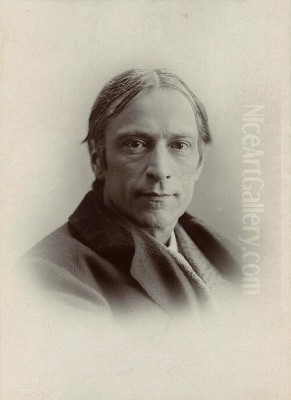
Sir Hubert von Herkomer CVO RA stands as a fascinating and remarkably versatile figure in the landscape of late Victorian and Edwardian art. Born in Germany but forging his career primarily in Britain, Herkomer navigated the complex currents of nineteenth-century European culture, achieving fame not only as a painter of poignant social realism and striking portraits but also as an accomplished printmaker, educator, composer, dramatist, and even a pioneering filmmaker and motorist. His life and work reflect a dynamic engagement with the artistic, social, and technological changes of his time, leaving a multifaceted legacy that continues to intrigue art historians. Awarded a knighthood in 1907 and inheriting a Bavarian barony (allowing the use of "von") in 1899, his titles reflect his unique position straddling German heritage and British establishment success.
Early Life and Artistic Formation
Hubert Herkomer was born on May 26, 1849, in Waal, Bavaria, a region known for its strong craft traditions. His family background was modest but imbued with artistic inclinations; his father, Lorenz Herkomer, was a skilled woodcarver, and his mother, Josephine Niggl, was musically talented. This blend of practical craftsmanship and artistic sensitivity would profoundly shape Hubert's future endeavours. Economic hardship prompted the family to emigrate, first to the United States in 1851, settling briefly in Cleveland, Ohio. However, they returned to Europe after a few years, eventually settling in Southampton, England, in 1857.
His artistic education began locally at the Southampton School of Art. His father, recognizing his son's talent, played a crucial role in his early development, providing guidance and encouragement. Seeking more advanced training, Herkomer briefly studied at the prestigious Munich Academy, where he absorbed aspects of German realism. However, his most formative institutional training occurred back in England at the South Kensington Schools in London (later the Royal College of Art) under the tutelage of figures associated with the burgeoning field of illustration and social commentary.
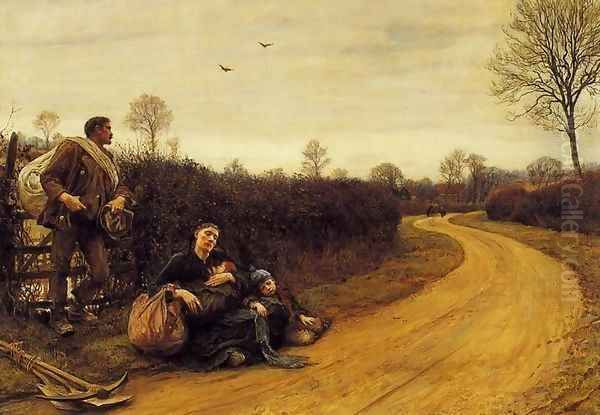
The London of the 1860s and 1870s offered fertile ground for an ambitious young artist. Herkomer quickly found work as an illustrator, most notably for the newly founded illustrated newspaper The Graphic, launched in 1869 by William Luson Thomas. This publication aimed to combine high-quality visuals with reportage and social commentary. Working for The Graphic placed Herkomer alongside other talented artists like Luke Fildes and Frank Holl, who were also developing a powerful visual language for depicting the realities of urban and rural poverty. Herkomer's wood engravings, often based on his own drawings and watercolours, gained attention for their dramatic compositions and empathetic portrayal of working-class life.
Rise to Prominence: Social Realism and the Royal Academy
Herkomer's transition from illustrator to fine art painter was marked by a series of increasingly ambitious works exhibited at the Royal Academy of Arts in London. His breakthrough came in 1875 with The Last Muster: Sunday at the Royal Hospital, Chelsea. This large-scale oil painting depicted elderly war veterans attending a chapel service. Its detailed realism, combined with a palpable sense of pathos and national sentiment, captivated the public and critics alike. The work was highly praised at the Royal Academy exhibition and later won the Grand Medal of Honour at the Paris Exposition Universelle of 1878, cementing Herkomer's reputation on an international stage.
Following this success, Herkomer continued to explore themes of social realism, drawing on his observations of contemporary life, particularly the hardships faced by the rural and urban poor. His Bavarian heritage often informed his choice of subjects, lending an authentic touch to his depictions of peasant life. However, he became most renowned for his powerful images addressing British social conditions. His 1885 painting, Hard Times, is arguably his most famous work in this vein. It portrays an itinerant agricultural labourer and his family resting by the roadside, their exhaustion and poverty starkly rendered. The painting became an iconic image of rural deprivation during a period of agricultural depression.
Another significant work exploring labour and social conflict was On Strike (1891). This painting depicts a confrontation between a determined striker, his anxious wife holding their child, and the unseen forces of management or authority. It captured the tensions of industrial relations in late Victorian Britain with a dramatic intensity characteristic of Herkomer's style. These works placed him firmly within the British Social Realist movement, alongside artists like Luke Fildes, whose Applicants for Admission to a Casual Ward also caused a sensation. Herkomer's approach, influenced partly by the British artist Frederick Walker, combined detailed observation with a strong narrative and emotional element, making his paintings accessible and impactful for a wide audience. His success was recognized by the Royal Academy, where he was elected an Associate (ARA) in 1879 and a full Royal Academician (RA) in 1890.
The Portraitist
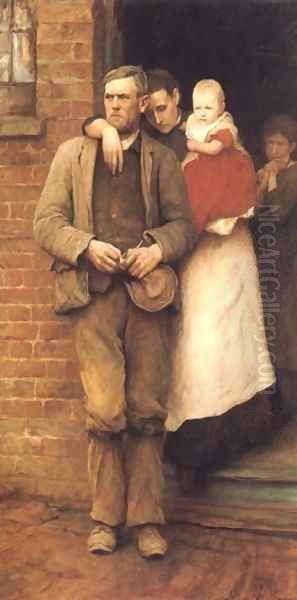
Alongside his work in social realism, Herkomer built a highly successful and lucrative career as a portrait painter. His ability to capture not only a likeness but also the perceived character and status of his sitters made him highly sought after by the prominent figures of the day. His portraits are often characterized by their strong presence, dramatic lighting, and vigorous brushwork, particularly in the depiction of male subjects, where he seemed most comfortable. He painted leading figures from various fields, including politics, the arts, science, and industry.
Among his most notable sitters were the influential art critic John Ruskin, the Poet Laureate Alfred, Lord Tennyson, and the composer Richard Wagner, whom he painted during a visit to Bayreuth. He also created memorable portraits of fellow artists, military figures, and intellectuals. His portrait of the war correspondent Archibald Forbes is a powerful study in rugged determination. Later in his career, in 1911, he painted a striking portrait of a young Winston Churchill, capturing the future leader's ambition and intensity. His connection with American art circles is evidenced by his acquaintance with figures like the portraitist Frederick Porter Vinton.
Herkomer's portrait practice was prolific. He developed a system for managing commissions efficiently, sometimes employing assistants for preparatory work, though the final execution and characterization remained distinctly his own. While some critics occasionally found his portraits overly dramatic or lacking in subtlety compared to contemporaries like John Singer Sargent, their power and psychological insight were widely acknowledged. His success in portraiture provided him with significant financial independence, enabling him to pursue his diverse range of other interests.
Master of Multiple Media: Etching and Watercolour
Herkomer's artistic talents extended well beyond oil painting. He was a highly skilled printmaker, particularly adept in the technique of etching. During the late nineteenth century, there was a significant revival of interest in etching as an original art form, championed by artists like James McNeill Whistler and Sir Francis Seymour Haden. Herkomer embraced the medium with enthusiasm, producing numerous plates that showcased his technical virtuosity and his ability to translate his painterly concerns into linear terms.
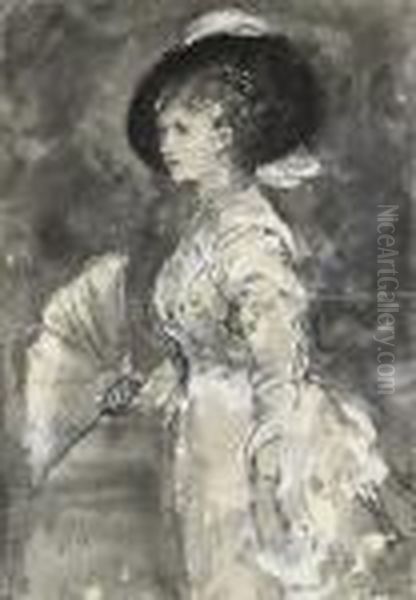
His etchings often explored similar themes to his paintings, including portraits, genre scenes, and landscapes. Works like his Portrait of Philip Gilbert Hamerton (an influential art critic and writer on etching) demonstrate his ability to capture character with fine, expressive lines. Other etchings, such as A Study, reveal his mastery of light and shadow, creating atmospheric and evocative images. He experimented with different etching techniques, including drypoint, to achieve varied textures and tones. His contributions to the medium were recognized with his election to the Royal Society of Painter-Etchers and Engravers (now the Royal Society of Painter-Printmakers).
Watercolour was another medium in which Herkomer excelled. From his early days as an illustrator, he had used watercolour for preparatory sketches and finished works. He brought a painterly robustness to the medium, often using bodycolour (gouache) to achieve opacity and depth, a technique influenced by artists like Frederick Walker. His watercolours frequently depicted rural scenes, landscapes, and figure studies, often imbued with the same social awareness found in his oils. His skill in this demanding medium led to his election to the prestigious Royal Watercolour Society (RWS), first as an Associate in 1893 and then as a full member in 1894.
The Educator: Oxford and the Bushey School
A significant aspect of Herkomer's career was his commitment to art education. In 1885, he was appointed Slade Professor of Fine Art at the University of Oxford, a prestigious position previously held by John Ruskin. During his tenure, which lasted until 1894, Herkomer delivered lectures on various aspects of art history, theory, and practice. His approach was often practical and grounded in his own experiences as a working artist, offering students insights into technique and the professional art world. His lectures were well-attended and later published, contributing to contemporary discourse on art.
However, Herkomer's most enduring educational legacy lies in the art school he founded in Bushey, Hertfordshire. In 1883, he established the Herkomer School of Art, which quickly grew into a major institution, attracting students from Britain, the Commonwealth, and the United States. Located near his home, Lululaund (an ambitious, self-designed house), the school offered a curriculum based on Herkomer's principles, emphasizing rigorous drawing from life, direct observation, and versatility across different media.
The Bushey school operated outside the traditional academic structures of London, offering a more personal and perhaps more progressive environment. Herkomer himself was actively involved in teaching, critiquing student work, and fostering a communal atmosphere. The school trained an estimated 500 to 600 artists during its existence (it closed in 1904). Notable students included Lucy Kemp-Welch, who became famous for her paintings of horses, particularly illustrations for Black Beauty. The presence of the school transformed Bushey into a thriving artists' colony, and its influence extended widely through its numerous graduates.
A Pioneer Beyond the Canvas: Theatre, Music, Film, and Motoring
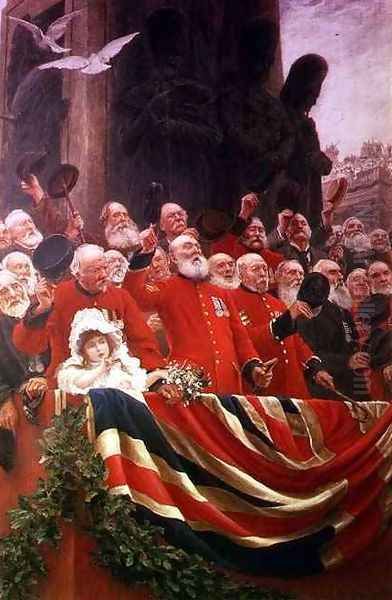
Herkomer's restless energy and boundless curiosity led him far beyond the traditional confines of painting and printmaking. He possessed a remarkable range of talents and interests, embracing new technologies and artistic forms with characteristic enthusiasm. He was deeply involved in music and theatre, composing scores, writing libretti, designing sets and costumes, and even acting and directing. At his Bushey home, Lululaund, he built a small theatre where he staged elaborate productions, often involving his students and local residents. These ranged from musical plays to historical pageants, showcasing his flair for spectacle and Gesamtkunstwerk (total work of art).
Even more remarkably, Herkomer became a pioneer in the nascent art of filmmaking. Around 1905, he established a film studio at Bushey, one of the earliest in Britain. He directed and produced several short films, often based on his own pictorial ideas or dramatic scenarios. He experimented with cinematic techniques, including lighting and composition, applying his painter's eye to the new medium. Although his film career was relatively short-lived and few of his films survive, his involvement places him among the first established artists to recognize and explore the potential of cinema.
His embrace of modernity also extended to technology. Herkomer was an early motoring enthusiast at a time when automobiles were still a novelty and often viewed with suspicion. He owned several cars and actively promoted motoring, helping to organize rallies and founding the Herkomer Konkurrenz in Germany in 1905, a challenging endurance trial for touring cars that became a major international event for several years. His passion for motoring reflected his broader interest in progress, innovation, and the changing pace of modern life. This extraordinary range of activities marks Herkomer as a unique figure, a Victorian polymath driven by an insatiable creative impulse.
Personal Life, Identity, and Controversy
Herkomer's personal life was marked by both deep affections and considerable complexity, reflecting his dual German-British identity and the social constraints of his time. He married three times. His first wife, Anna Weise, whom he married in 1873, died young in 1883. Deeply affected, Herkomer later built the 'Mutterturm' (Mother Tower) in his Bavarian hometown of Landsberg am Lech as a memorial to her and his mother, a striking Romanesque-inspired structure that still stands today.
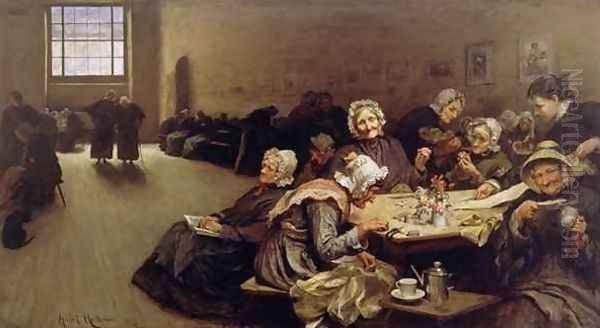
His second marriage, in 1884, was to Lulu Griffiths. Tragically, she died just a year later. His third marriage, in 1888, was to Margaret Griffiths, Lulu's sister. This union caused significant controversy. At the time, the Deceased Wife's Sister's Marriage Act had not yet been passed in England, making such marriages illegal within the country (though permissible elsewhere). To legally marry Margaret, Herkomer had to temporarily renounce his British citizenship and become a German citizen again, marrying her in Bavaria. This situation highlighted the complexities of his national identity and attracted public attention. He was able to regain British nationality later, and the law in England eventually changed in 1907.
His German origins and strong ties to Bavaria remained a constant throughout his life, even as he became a pillar of the British art establishment. He frequently visited Germany, maintained connections there, and incorporated Bavarian themes into his art. This dual allegiance, however, became problematic with the rising political tensions leading up to World War I. Although he died just before the war began, the anti-German sentiment that swept Britain during the conflict retrospectively cast a shadow over his legacy for a time, contributing to a period where his significant contributions were somewhat overlooked. Furthermore, his sheer versatility sometimes attracted criticism, with suggestions that he spread his talents too thinly, a "jack of all trades" unable to achieve ultimate mastery in any single field – a critique perhaps unfair given his substantial achievements across multiple domains.
Style, Technique, and Artistic Context
Sir Hubert von Herkomer's artistic style is primarily associated with realism, particularly the social realism that characterized much of his most impactful work. His paintings demonstrate meticulous attention to detail, strong draughtsmanship derived from his German training and illustration background, and a powerful sense of narrative. He often employed dramatic lighting and compositions to heighten the emotional impact of his scenes, whether depicting the quiet dignity of Chelsea pensioners in The Last Muster or the stark despair of the family in Hard Times.
His influences were diverse. The detailed, anecdotal style of German genre painters like Franz von Defregger and Wilhelm Leibl can be detected in his work, particularly in his depictions of peasant life. In Britain, the idealism and watercolour techniques of Frederick Walker were a significant inspiration, especially in his handling of rural subjects and his use of bodycolour. While aware of contemporary European movements, Herkomer's work remained largely distinct from French Impressionism, with its focus on capturing fleeting effects of light and colour (as seen in the work of Claude Monet or Camille Pissarro). He also stood apart from the aestheticism and symbolism of the later Pre-Raphaelites like Dante Gabriel Rossetti or Edward Burne-Jones, grounding his art firmly in observable reality and social commentary.
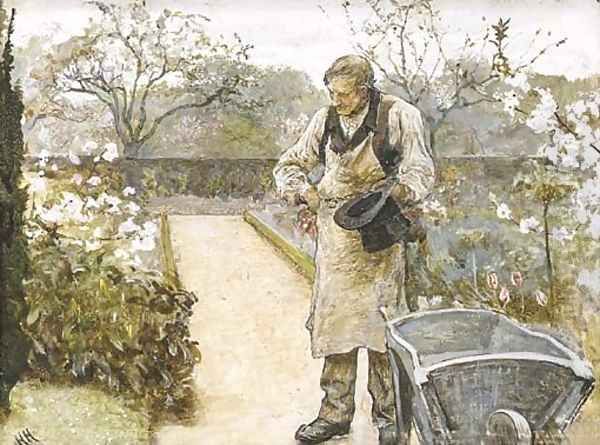
His technical proficiency was evident across various media. In oil painting, he often used a robust application of paint, sometimes employing bitumen which unfortunately led to darkening in some works over time. His etchings reveal a mastery of line and tone, while his watercolours show a confident handling of both transparent washes and opaque bodycolour. His innovative spirit extended to his experiments with enamel painting and his unique combination of techniques in portraiture, sometimes incorporating photographic aids in the preparatory stages, a practice common among many Victorian artists but occasionally frowned upon by purists.
Legacy and Influence
Sir Hubert von Herkomer's influence during his lifetime was considerable, though his reputation experienced fluctuations after his death in 1914. His impact can be seen in several areas. His powerful social realist paintings contributed significantly to the Victorian consciousness of poverty and labour issues, influencing public opinion and inspiring other artists to tackle similar themes. His work resonated internationally; notably, Vincent van Gogh greatly admired Herkomer's illustrations in The Graphic, seeing in them a model for the kind of socially engaged art he aspired to create. Van Gogh specifically mentioned Herkomer's ability to convey deep feeling and character, even considering seeking him out for guidance.
The Herkomer School of Art in Bushey had a lasting impact, training hundreds of artists and establishing Bushey as an important art centre. The school's emphasis on direct observation and technical versatility shaped the practice of its many students. Today, the Bushey Museum and Art Gallery holds a significant collection of his work and archives, preserving the legacy of the artist and the school he founded. His pioneering activities in film, theatre, and music, while less central to his artistic fame, mark him as an unusually forward-looking figure for his time, anticipating the cross-media explorations of later artists.
While the rise of modernism in the early twentieth century led to a decline in appreciation for Victorian narrative painting, recent decades have seen a renewed interest in Herkomer's work. Art historians now recognize the breadth of his achievements, his technical skill, and the significance of his contribution to social realism, portraiture, and art education. He remains a compelling example of a highly successful Victorian artist who navigated the complexities of his era with extraordinary energy and talent, leaving behind a rich and varied body of work that reflects both his personal vision and the spirit of his age. His position as a bridge between German and British artistic traditions also adds a unique dimension to his historical importance.
Conclusion
Sir Hubert von Herkomer was far more than just a painter; he was a force of nature within the Victorian and Edwardian art worlds. From his origins in Bavaria to his knighthood in Britain, his life encompassed remarkable social mobility and artistic diversification. His powerful images of social conditions stirred the conscience of a nation, while his portraits captured the likenesses of an era's leading figures. As an educator, innovator, and pioneer in fields ranging from printmaking to cinema, he demonstrated a relentless creativity and a modern sensibility. Though overshadowed for a time by subsequent art movements, Herkomer's multifaceted career and substantial body of work secure his place as a significant and endlessly fascinating figure in the history of British and European art. His legacy endures in his paintings, prints, the institutions he influenced, and the story of his remarkably versatile life.